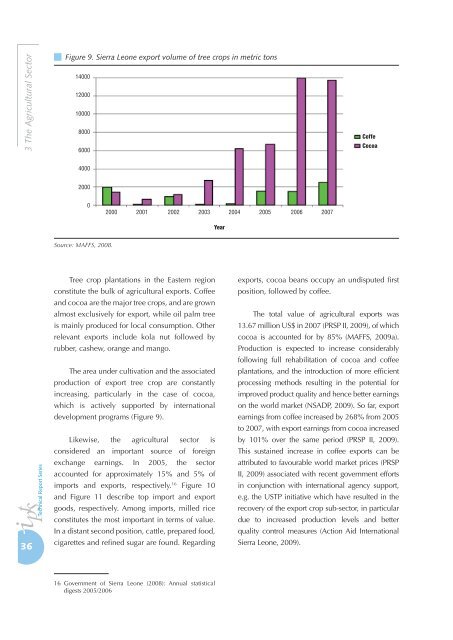SIERRA LEONE maq 4ª.indd - agrilife - Europa
SIERRA LEONE maq 4ª.indd - agrilife - Europa
SIERRA LEONE maq 4ª.indd - agrilife - Europa
You also want an ePaper? Increase the reach of your titles
YUMPU automatically turns print PDFs into web optimized ePapers that Google loves.
3 The Agricultural Sector<br />
36<br />
Figure 9. Sierra Leone export volume of tree crops in metric tons<br />
Source: MAFFS, 2008.<br />
Tree crop plantations in the Eastern region<br />
constitute the bulk of agricultural exports. Coffee<br />
and cocoa are the major tree crops, and are grown<br />
almost exclusively for export, while oil palm tree<br />
is mainly produced for local consumption. Other<br />
relevant exports include kola nut followed by<br />
rubber, cashew, orange and mango.<br />
The area under cultivation and the associated<br />
production of export tree crop are constantly<br />
increasing, particularly in the case of cocoa,<br />
which is actively supported by international<br />
development programs (Figure 9).<br />
Likewise, the agricultural sector is<br />
considered an important source of foreign<br />
exchange earnings. In 2005, the sector<br />
accounted for approximately 15% and 5% of<br />
imports and exports, respectively. 16 Figure 10<br />
and Figure 11 describe top import and export<br />
goods, respectively. Among imports, milled rice<br />
constitutes the most important in terms of value.<br />
In a distant second position, cattle, prepared food,<br />
cigarettes and refined sugar are found. Regarding<br />
16 Government of Sierra Leone (2008): Annual statistical<br />
digests 2005/2006<br />
exports, cocoa beans occupy an undisputed first<br />
position, followed by coffee.<br />
The total value of agricultural exports was<br />
13.67 million US$ in 2007 (PRSP II, 2009), of which<br />
cocoa is accounted for by 85% (MAFFS, 2009a).<br />
Production is expected to increase considerably<br />
following full rehabilitation of cocoa and coffee<br />
plantations, and the introduction of more efficient<br />
processing methods resulting in the potential for<br />
improved product quality and hence better earnings<br />
on the world market (NSADP, 2009). So far, export<br />
earnings from coffee increased by 268% from 2005<br />
to 2007, with export earnings from cocoa increased<br />
by 101% over the same period (PRSP II, 2009).<br />
This sustained increase in coffee exports can be<br />
attributed to favourable world market prices (PRSP<br />
II, 2009) associated with recent government efforts<br />
in conjunction with international agency support,<br />
e.g. the USTP initiative which have resulted in the<br />
recovery of the export crop sub-sector, in particular<br />
due to increased production levels and better<br />
quality control measures (Action Aid International<br />
Sierra Leone, 2009).
















